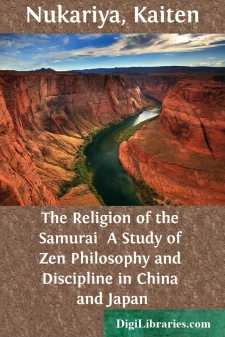Categories
- Antiques & Collectibles 13
- Architecture 36
- Art 48
- Bibles 22
- Biography & Autobiography 813
- Body, Mind & Spirit 142
- Business & Economics 28
- Children's Books 17
- Children's Fiction 14
- Computers 4
- Cooking 94
- Crafts & Hobbies 4
- Drama 346
- Education 46
- Family & Relationships 57
- Fiction 11829
- Games 19
- Gardening 17
- Health & Fitness 34
- History 1377
- House & Home 1
- Humor 147
- Juvenile Fiction 1873
- Juvenile Nonfiction 202
- Language Arts & Disciplines 88
- Law 16
- Literary Collections 686
- Literary Criticism 179
- Mathematics 13
- Medical 41
- Music 40
- Nature 179
- Non-Classifiable 1768
- Performing Arts 7
- Periodicals 1453
- Philosophy 64
- Photography 2
- Poetry 896
- Political Science 203
- Psychology 42
- Reference 154
- Religion 513
- Science 126
- Self-Help 84
- Social Science 81
- Sports & Recreation 34
- Study Aids 3
- Technology & Engineering 59
- Transportation 23
- Travel 463
- True Crime 29
The Religion of the Samurai A Study of Zen Philosophy and Discipline in China and Japan
by: Kaiten Nukariya
Description:
Excerpt
Buddhism is geographically divided into two schools[FN#1]—the Southern, the older and simpler, and the Northern, the later and more developed faith. The former, based mainly on the Pali texts[FN#2] is known as Hinayana[FN#3] (small vehicle), or the inferior doctrine; while the latter, based on the various Sanskrit texts,[4] is known as Mahayana (large vehicle), or superior doctrine. The chief tenets of the Southern School are so well known to occidental scholars that they almost always mean the Southern School by the word Buddhism. But with regard to the Northern School very little is known to the West, owing to the fact that most of its original texts were lost, and that the teachings based on these texts are written in Chinese, or Tibetan, or Japanese languages unfamiliar to non-Buddhist investigators.
[FN#1] The Southern School has its adherents in Ceylon, Burma, Siam,
Anan, etc.; while the Northern School is found in Nepal, China,
Japan, Tibet, etc.
[FN#2] They chiefly consist of the Four Nikayas: (1) Digha Nikaya (Dirghagamas, translated into Chinese by Buddhaya?as, A.D. 412-413); (2) Majjhima Nikaya (Madhyamagamas, translated into Chinese by Gautama Sanghadeva, A.D. 397-398); (3) Sanyutta Nikaya (Samyuktagamas, translated into Chinese by Gunabhadra, of the earlier Sung dynasty, A.D. 420 479); (4) Anguttara Nikaya (Ekottaragamas, translated into Chinese by Dharmanandi, A.D. 384-385). Out of these Hinayana books, the English translation of twenty-three suttas by Rhys Davids exist in 'Sacred Books of Buddhist,' vols. ii.-iii., and of seven suttas by the same author in 'Sacred Books of the East,' vol. xi.
[FN#3] The Southern Buddhists never call their faith Hinayana, the name being an invention of later Buddhists, who call their doctrine Mahayana in contradistinction to the earlier form of Buddhism. We have to notice that the word Hinayana frequently occurs in Mahayana books, while it does not in Hinayana books.
[FN#4] A catalogue of the Buddhist Canon, K'-yuen-luh, gives the titles of 897 Mahayana sutras, yet the most important books often quoted by Northern Buddhist teachers amount to little more than twenty. There exist the English translation of Larger Sukhavati-vyuha-sutra, Smaller Sukhavati-vyuha-sutra, Vajracchedika-sutra, Larger Prajna-paramita-hradya-sutra, Smaller Prajna-paramita-hrdaya-sutra, by Max M?ller, and Amitayur-dhyana-sutra, by J. Takakusu, in 'Sacred Books of the East,' vol. xlix. An English translation of Saddharma-pundarika-sutra, by Kern, is given in 'Sacred Books of the East,' Vol. xxi. Compare these books with 'Outlines of Mahayana Buddhism,' by D. Suzuki.
It is hardly justifiable to cover the whole system of Buddhism with a single epithet[FN#5] 'pessimistic' or 'nihilistic,' because Buddhism, having been adopted by savage tribes as well as civilized nations, by quiet, enervated people as well as by warlike, sturdy hordes, during some twenty-five hundred years, has developed itself into beliefs widely divergent and even diametrically opposed. Even in Japan alone it has differentiated itself into thirteen main sects and forty-four sub-sects[FN#6] and is still in full vigour, though in other countries it has already passed its prime. Thus Japan seems to be the best representative of the Buddhist countries where the majority of people abides by the guiding principle of the Northern School. To study her religion, therefore, is to penetrate into Mahayanism, which still lies an unexplored land for the Western minds. And to investigate her faith is not to dig out the remains of Buddhist faith that existed twenty centuries ago, but to touch the heart and soul of Mahayanism that enlivens its devotees at the present moment.
[FN#5] Hinayanism is, generally speaking, inclined to be pessimistic, but Mahayanism in the main holds the optimistic view of life....


